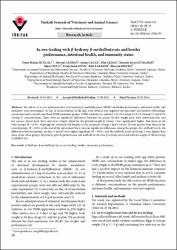In ovo feeding with β-hydroxy β-methylbutyrate and broiler performance, intestinal health, and immunity status

Göster/
Erişim
info:eu-repo/semantics/openAccessTarih
2016Yazar
Muğlalı, Ömer HakanSalman, Mustafa
Gacar, Ayhan
Akdağ, Filiz
Gülbahar, Mustafa Yavuz
Çiftçi, Alper
Onuk, Ertan Emek
Karadaş, Filiz
Eseceli, Hüseyin
Üst veri
Tüm öğe kaydını gösterÖzet
The effects of in ovo administration of #946;-hydroxy- #946;-methylbutyrate (HMB) on broiler performance, intestinal health, and immunity were investigated. At day 18 of incubation, fertile eggs were divided into negative (no injection) and positive (physiologic serum injection) controls and three HMB treatment groups. HMB solution was injected at 0.1% (Group 1), 0.2% (Group 2), and 0.3% (Group 3) concentrations. There were no significant differences between the groups for live weight gain, feed conversion rate, and hot carcass, breast meat, liver, and heart weight. However, the gizzard weight in Group 1 was significantly higher than those in the other groups (P < 0.05). Although the intestinal villi lengths in the treatment Groups 1 and 3 on day 20 were greater than those in the control groups (P < 0.01), at the end of the experiment there were no significant differences among the groups. For antibody levels, the differences between groups on days 4 and 42 were highly significant (P < 0.01), and the antibody levels in Group 2 were higher than those in the other groups. Separately, growth performance and antibody levels were positively correlated with the length of villi in Group 2 (HMB 0.2%). The effects of in ovo administration of #946;-hydroxy- #946;-methylbutyrate (HMB) on broiler performance, intestinal health, and immunity were investigated. At day 18 of incubation, fertile eggs were divided into negative (no injection) and positive (physiologic serum injection) controls and three HMB treatment groups. HMB solution was injected at 0.1% (Group 1), 0.2% (Group 2), and 0.3% (Group 3) concentrations. There were no significant differences between the groups for live weight gain, feed conversion rate, and hot carcass, breast meat, liver, and heart weight. However, the gizzard weight in Group 1 was significantly higher than those in the other groups (P < 0.05). Although the intestinal villi lengths in the treatment Groups 1 and 3 on day 20 were greater than those in the control groups (P < 0.01), at the end of the experiment there were no significant differences among the groups. For antibody levels, the differences between groups on days 4 and 42 were highly significant (P < 0.01), and the antibody levels in Group 2 were higher than those in the other groups. Separately, growth performance and antibody levels were positively correlated with the length of villi in Group 2 (HMB 0.2%).

















